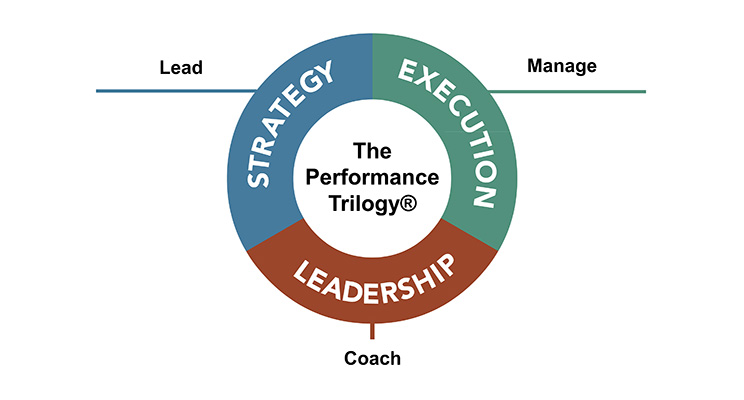In my previous blog on the Performance Trilogy®, (Insert the link to the blog here) the secret to becoming a great leader was to focus on three core processes; strategy, execution and development. Understanding each of these processes and utilizing the process tools however is necessary but not sufficient for success. Specific leadership actions are required during each of the three processes to inspire staff and keep them committed. If staff are disengaged, you need to look in the mirror and take ownership of the problem. In this article, a leadership framework is introduced focused on the actions you must take as a leader to generate the following emotions: inspire faith in your strategy, confidence in your execution and trust in your motives.
Leadership is a concept that everyone knows when he or she sees it, but that few really understand the complexity or “formula” for leadership. If you ask ten people to define leadership, you will get ten different answers. If you search the word leadership in Google, you will get over 100 million hits. Such a plethora of perspectives gives the impression that the concept of leadership is well defined and understood. However, whenever I have asked participants in my leadership and management courses their understanding of the term leadership, I have gotten vague answers that vary widely based on their own specific experiences. My sample size is over a thousand senior scientists, engineers and technical managers taken over a period of 40 years across multiple cultures in the US, Latin America, Europe, and the Middle East.
I am confident that the generally accepted views on leadership have been distorted by myths that have been built up over the years. Thousands of books have been written about great political, religious, military, and business leaders that give the impression that leaders are born not made and that leadership is reserved for the very few best and brightest. Many management and leadership models have been proposed but few describe what leaders actually do. Popular books and articles are published continuously that promise quick fixes and magic bullets on management and leadership. These myths have prevented many technical managers and senior staff without business degrees from thinking of themselves as team or organizational leaders. As a result, many with high potential have hesitated to take appropriate steps to develop their leadership skills and take on more challenging assignments. Unfortunately, many more have been unsuccessfully thrust into management leadership roles without the proper understanding, perspective or training. In my experience, it is rare to find technical managers who skilled in all three of the processes in the Performance Trilogy®.
I believe that everyone is born with leadership talent and can develop additional skills that will allow them to successfully execute the Performance Trilogy®. Webster defines a leader as “one who guides”. The management literature defines leaders as those people who achieve goals. Each of these definitions captures elements of leadership but provide no guidance on what to do during the lifecycle of an initiative or how to elicit feedback on how well you are doing. I offer the following definition and resulting model based on over 40 years of personal successes and failures in leading and coaching scientists and engineers in the US, Latin America, Europe, and the Middle East; and reading over 200 books on leadership and management over the course of my career.
“Leadership is the art and science of creating the future by inspiring others to follow you to your desired destination (the role of the leader), building their confidence in the path taken (the role of the manager), and gaining their trust that you have their interests at heart (the role of the coach). The essence of leadership is the ability to transform ideas into significant results.”
As a disciple of the late Dr. Bill Hitt, Battelle’s Director of leadership development at Battelle, I will always remember him repeating the last sentence in the above definition.
While this definition seems straightforward and perhaps simplistic, as you shall see, even if you are skilled enough to create an excellent strategy, it takes a great deal of self-awareness, skill development and hard work to successfully lead it through to completion. There are no magic bullets. The leading Harvard expert on leadership, John Kotter, has suggested that 70% of all corporate strategies fail to achieve their potential. I am confident that by adopting the Performance Trilogy® framework you will increase the odds of success dramatically.
Leading each of the three processes of the Performance Trilogy requires that you assume different roles and manage distinct responsibilities during each phase of your initiative. In Phase 1, your role is to “lead from the front” to create and promote a compelling strategy that inspires faith among your team. This is the most traditional view of “leadership”. In Phase 2, your role is to “lead from the middle” to build confidence among your team with your ability to execute the strategy to produce results. This is the traditional view of “management”. In Phase three, your role is to “lead from the rear” to gain your team’s trust by empowering them, guiding them and helping them grow as leaders. This is the traditional view of “coaching”. Ultimately, in my mind asking whether someone is a leader or a manager is the wrong question. Using the Performance Trilogy® Framework, successful and sustainable leadership involves all three roles; leading, managing and coaching during each of the three phases of every initiative.
Graffeo and Associates is an organization committed to improving the quality of leadership in science and technology (S&T). It was formed in 2008 around the expertise of Dr. Tony Graffeo, a senior executive from Arthur D. Little and Battelle Memorial Institute. Dr. Graffeo has consulted with leading research institutions in the United States, Europe, Latin America and the Middle East, and has created a codified system of leadership development centered around the principles of the Performance Trilogy® which he has taught throughout the world. He is currently a professor at Northeastern University teaching Professional Masters entrepreneurship and leadership courses. His new book, titled “Leading Science & Technology-Based Organizations: Mastering the Fundamentals of Personal, Managerial, and Executive Leadership” will be published in 2018.



